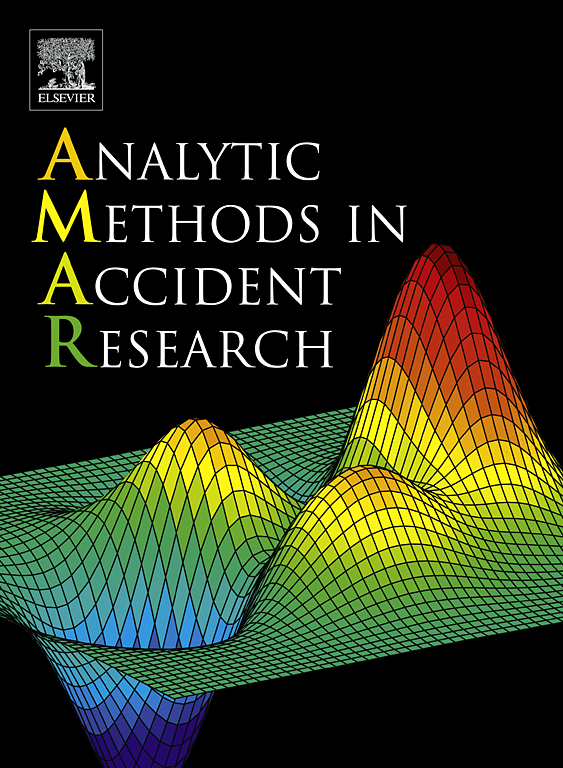用计量经济学方法研究行人和骑自行车者受伤严重程度分析中时间变化的开始和持续时间
IF 12.6
1区 工程技术
Q1 PUBLIC, ENVIRONMENTAL & OCCUPATIONAL HEALTH
引用次数: 0
摘要
现有安全文献中有大量证据表明,在伤害严重程度分析中,外生变量的影响很可能是时变的。这些早期研究大多按碰撞年份测试了外生变量的时变效应。然而,变量效应在一年内可能会有变化,而相同的效应可能会在前几年的部分或全部时间内延续。为此,在本研究中,我们提出了一个灵活的框架,以确定模型估计中的时变效应何时可能出现(时变的起始时间)以及这种时变效应会持续多久(时变的持续时间)。在研究设计中,我们假定时间变化的起始点可以是一年中的任何一个季度,而时间变化效应可以在可变效应的时间变化起始点之后的不同季度中持续。伤害严重程度模型是利用相关随机参数广义有序 Logit 公式和片断线性函数进行估计的。实证分析采用了澳大利亚昆士兰州 2015 年至 2020 年的主动旅行者(行人和骑自行车者)碰撞数据。通过计算弹性效应,进一步扩充了估算结果。结果表明,对于几个变量来说,不同年份的时变效应可能不同,而对于其他变量来说,时变效应的开始时间可能不同于一年的开始时间。模型规格的这种灵活性可能会对制定和实施有效的对策产生重大影响,因为它使我们能够了解道路交通伤害是如何随时间演变的,以及何时可能出现新的道路安全问题。本文章由计算机程序翻译,如有差异,请以英文原文为准。
Econometric approaches to examine the onset and duration of temporal variations in pedestrian and bicyclist injury severity analysis
There is considerable evidence in existing safety literature that the exogenous variable effects are likely to be time-varying in the injury severity analysis. The majority of these earlier studies tested time-varying effects of exogenous variables by crash year. However, there might be variability in the variable effects within a year, while the same effect might carry over in some or all parts of the preceding years. Towards that end, in this study, we propose a flexible framework to identify when the time-varying effect is likely to occur (the onset of temporal variation) and how long such time-varying effect lasts (duration of temporal variation) in the model estimates. In the study design, we assume that the onset of temporal variation can be any quarter of a year under consideration, while the time-varying effect can continue over different quarters after the onset of temporal variation in a variable effect. The injury severity model is estimated by using Correlated Random Parameter Generalized Ordered Logit formulation with piecewise linear functions. The empirical analysis is demonstrated by employing active traveler (pedestrian and bicyclist) crash data from Queensland, Australia for the years 2015 through 2020. The estimation results are further augmented by computing elasticity effects. The results indicate that the time-varying effects are likely to be different across years for several variables, while for other variables, the onset of time-varying effects could be different than the start of a year. Such flexibility in model specification is likely to have significant implications for devising and implementing effective countermeasures since it allows us to understand how road traffic injuries are evolving over time and when a new road safety issue might be arising.
求助全文
通过发布文献求助,成功后即可免费获取论文全文。
去求助
来源期刊

Analytic Methods in Accident Research
Multiple-
CiteScore
22.10
自引率
34.10%
发文量
35
审稿时长
24 days
期刊介绍:
Analytic Methods in Accident Research is a journal that publishes articles related to the development and application of advanced statistical and econometric methods in studying vehicle crashes and other accidents. The journal aims to demonstrate how these innovative approaches can provide new insights into the factors influencing the occurrence and severity of accidents, thereby offering guidance for implementing appropriate preventive measures. While the journal primarily focuses on the analytic approach, it also accepts articles covering various aspects of transportation safety (such as road, pedestrian, air, rail, and water safety), construction safety, and other areas where human behavior, machine failures, or system failures lead to property damage or bodily harm.
 求助内容:
求助内容: 应助结果提醒方式:
应助结果提醒方式:


